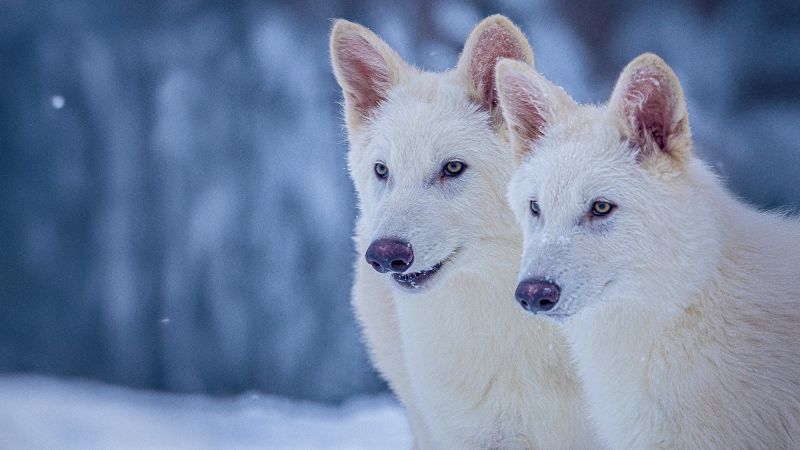In a groundbreaking scientific achievement, the extinct dire wolf is making a dramatic comeback, thanks to advancements in genetic engineering and cloning technologies. Dallas-based Colossal Biosciences has achieved the remarkable feat of bringing back the dire wolf, a creature that last roamed North America approximately 12,500 years ago. This article delves into the science and implications of this unprecedented development, exploring the future of de-extinction and its potential impact on conservation efforts.
A New Kind of Canine: The Cloned Dire Wolves
Colossal Biosciences announced the birth of three dire wolf puppies, showcasing an innovative approach to de-extinction. The dire wolf, scientifically known as Aenocyon dirus, was a top predator and a key player in its ecosystem. The puppies were created using ancient DNA obtained from fossils that are as much as 72,000 years old.
The process involved extracting DNA from dire wolf fossils and applying gene-editing techniques to alter the genes of modern gray wolves—the dire wolf’s closest living relative. The result is a hybrid that contains approximately 99.9% gray wolf DNA but also expresses distinctive traits associated with dire wolves, such as their characteristic robust build.
“This massive milestone is the first of many coming examples demonstrating that our end-to-end de-extinction technology stack works.” — Ben Lamm, Co-Founder, Colossal Biosciences.
The three puppies, named Romulus, Remus, and Khaleesi, were born at a secure, monitored site covering 2,000 acres. This facility is equipped with extensive security measures, including drones and live cameras, ensuring the safety and well-being of the animals.
The Science Behind the ‘De-Extinction’
The cloning process utilized ancient DNA from different dire wolf specimens to assemble two complete genomes. By comparing these genomes with those of living canids, scientists identified key genetic variants for traits unique to dire wolves. The knowledge allowed researchers to focus on gene editing, specifically targeting traits that would enable the wolf puppies to exhibit dire wolf characteristics.
While critics may argue about the ethical implications of gene editing and potential ecological consequences, Colossal’s team stands firm in their approach, emphasizing the importance of creating populations that reflect the essential characteristics of extinct species.
Future Implications for Conservation
The success with the dire wolf opens doors for other ambitious restoration projects, including efforts to revive the woolly mammoth, the dodo, and the Tasmanian tiger. Colossal Biosciences aims not only to bring back these species but also to infuse genetic diversity into endangered populations, such as the red wolf, which is critically endangered.
Colossal plans to leverage its experience from the dire wolf project to enhance the red wolf gene pool. As James, the chief animal officer at Colossal, explains, the goal is to utilize new cloning and genetic diversity tools to aid conservation efforts. By enhancing genetic diversity, researchers hope to ensure a more robust and adaptable population.
The Woolly Mammoth Project
Among the prominent targets in Colossal’s de-extinction efforts is the woolly mammoth. Preliminary research has involved editing 85 genes in modern Asian elephant DNA to match those of ancient woolly mammoths. The company has already made progress on 25 of those genes and aims to have mammoth embryos ready for implantation by 2026.
Colossal envisions creating hybrids that would resemble the woolly mammoth while also rewilding Arctic areas. This could potentially reverse some aspects of environmental degradation in these regions, which would contribute to efforts aimed at combating climate change.
The Dodo and Tasmanian Tiger
Another notable project involves the resurrection of the dodo bird. Extinct since the late 17th century, the dodo was a flightless bird native to Mauritius that fell victim to human exploitation. Colossal is discussing potential partnerships with the Mauritius government to tackle this restoration effort.
Colossal also aims to revive the Tasmanian tiger, known scientifically as the thylacine, which went extinct in the 20th century due to hunting and habitat loss. By using genetic insights from collected DNA samples, the company hopes to restore this lost marsupial.
Ethical Considerations of De-Extinction
While the de-extinction efforts are met with excitement from some corners of the scientific community, there are significant ethical considerations that must be addressed. Critics argue that the vast financial resources devoted to these projects could be better utilized for conservation efforts focused on existing endangered species.
Moreover, challenges remain concerning the ecological roles of reintroduced species. Experts express concerns about whether genetically resurrected species like the dire wolf can successfully integrate into modern ecosystems that have evolved since their extinction. According to environmental philosopher Christopher Preston, while the facility meets animal welfare standards, the integration of de-extinct species raises questions regarding their ecological impact.
Conclusion: A Path Forward?
The successful cloning of dire wolves by Colossal Biosciences marks a significant milestone in not just the field of de-extinction, but also conservation biology. As we stand on the cusp of potential breakthroughs with other species, the implications of this work may extend far beyond these individual endeavors.
Colossal’s work with the dire wolf exemplifies the intersection of advanced genetic technology and wildlife conservation, paving the way for potential reclamation of ecosystems and revitalization of endangered species through innovative approaches. As scientific understanding evolves, perhaps a new balance can be sought where extinct species can contribute meaningfully to biodiversity restoration efforts on our planet.
In managing the delicate threads of conservation, ethics, and scientific ambition, the future carries the weight of possibility. With an eye towards sustainable practices, we may not just gaze into the past, but rather set a path towards a future brimming with revitalized wildlife.

